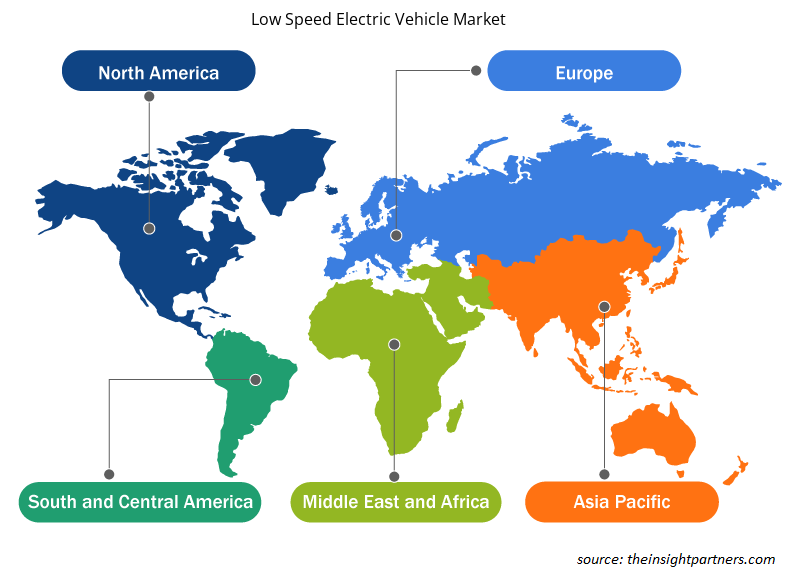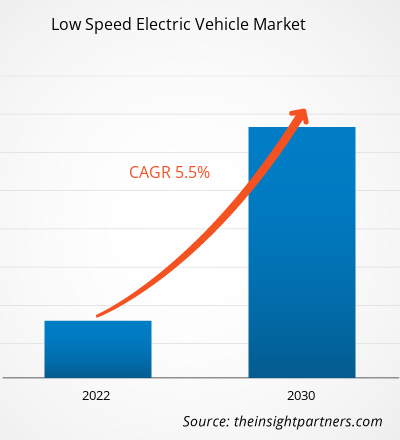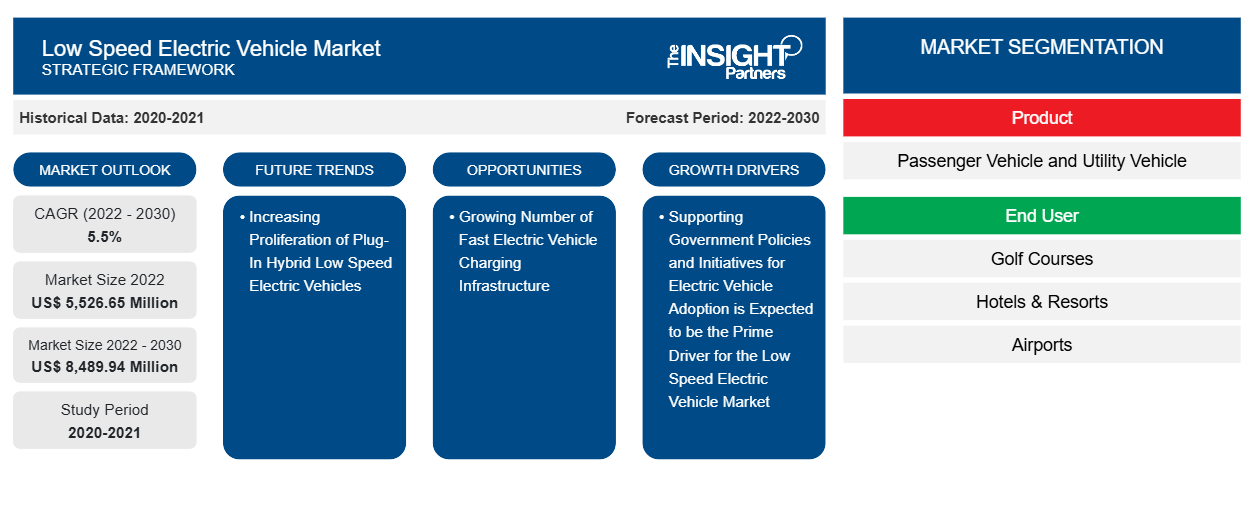低速電気自動車市場は2022年に55億2,665万米ドルに達し、 2022年から2030年にかけて5.5%のCAGRを記録し、2030年までに84億8,994万米ドルに達すると予想されています。燃費向上への重点がますます高まっており、これが市場の重要なトレンドであり続けると思われます。
低速電気自動車市場分析
世界の低速電気自動車市場はここ数年で目覚ましい変化を遂げており、環境に優しい自動車の取引と採用が大幅に増加しています。2022年には、持続可能なモビリティソリューションへの好みが高まっていることを反映して、電気自動車とハイブリッド車の輸入動向が目覚ましい進化を遂げました。特に、輸入される電気自動車とハイブリッド車の種類の大幅な変化が、低速電気自動車市場の世界的な発展を牽引しています。
低速電気自動車市場の概要
低速電気自動車市場は、完全電気自動車の販売が増加傾向にあることから、注目すべき変化を遂げています。消費者が環境に優しい代替品を好み、ディーゼル車から離れていくことで、予測期間中に低速電気自動車市場の進化が促進されると予想されます。自動車業界は、さまざまな立法者によって課せられた進化する排出規制を満たすために、代替ソリューションを導入しています。
要件に合わせてレポートをカスタマイズする
このレポートの一部、国レベルの分析、Excelデータパックなど、あらゆるレポートを無料でカスタマイズできます。また、スタートアップや大学向けのお得なオファーや割引もご利用いただけます。
-
このレポートの主要な市場動向を入手してください。この無料サンプルには、市場動向から見積もりや予測に至るまでのデータ分析が含まれます。
低速電気自動車市場の推進要因と機会
市場を有利に導く電気自動車導入のための政府の政策と取り組みを支援する
化石燃料による環境汚染の拡大は、政府にとって大きな懸念事項の 1 つです。環境汚染のレベルを下げるために、さまざまな政府が、販売時の特別割引、インセンティブ、有利なオファー、税制優遇措置などにより、消費者がよりクリーンで持続可能かつ環境に優しい代替品を採用することを強調しています。中国、日本、欧州連合、インド、カナダ、韓国は、政府が低速電気自動車の採用促進に積極的に取り組んでいる主要地域の一部であり、予測期間中に低速電気自動車市場の発展を後押しすると予想されています。
低速電気自動車の手頃な価格の上昇
バッテリーは電気自動車の主要部分です。技術の進歩とバッテリー価格の低下により、電気自動車はより手頃な価格になってきています。手頃な価格の拡大と、電気自動車を選択することで税額控除を提供する政府の取り組みの拡大により、今後数年間で低速電気自動車市場の成長が促進されると予想されます。
低速電気自動車市場レポートのセグメンテーション分析
低速電気自動車市場分析の導出に貢献した主要なセグメントは、製品とエンドユーザーです。
- 製品に基づいて、低速電気自動車市場は乗用車と実用車に分かれています。乗用車セグメントは2022年に大きな市場シェアを占めました。
- エンドユーザーに基づいて、低速電気自動車市場は、ゴルフコース、ホテルとリゾート、空港、住宅と商業施設、その他に分かれています。ゴルフコースセグメントは、2022年に大きな市場シェアを占めました。
低速電気自動車の地域別市場シェア分析
低速電気自動車市場レポートの地理的範囲は、主に北米、アジア太平洋、ヨーロッパ、中東およびアフリカ、南米および中米の 5 つの地域に分かれています。
低速電気自動車市場レポートの対象範囲は、北米(米国、カナダ、メキシコ)、欧州(ロシア、英国、フランス、ドイツ、イタリア、その他の欧州)、アジア太平洋(韓国、インド、オーストラリア、日本、中国、その他のアジア太平洋)、中東およびアフリカ(サウジアラビア、南アフリカ、UAE、その他の中東およびアフリカ)、南米および中米(アルゼンチン、ブラジル、その他の南米および中米)です。収益面では、2022年に北米が低速電気自動車市場のシェアを独占しました。アジア太平洋は、世界の低速電気自動車市場への2番目に大きな貢献者であり、ヨーロッパがそれに続きます。
低速電気自動車市場の地域別洞察
予測期間を通じて低速電気自動車市場に影響を与える地域的な傾向と要因は、Insight Partners のアナリストによって徹底的に説明されています。このセクションでは、北米、ヨーロッパ、アジア太平洋、中東、アフリカ、南米、中米にわたる低速電気自動車市場のセグメントと地理についても説明します。

- 低速電気自動車市場の地域別データを入手
低速電気自動車市場レポートの範囲
| レポート属性 | 詳細 |
|---|---|
| 2022年の市場規模 | 55億2,665万米ドル |
| 2030年までの市場規模 | 84億8,994万米ドル |
| 世界のCAGR(2022年 - 2030年) | 5.5% |
| 履歴データ | 2020-2021 |
| 予測期間 | 2022-2030 |
| 対象セグメント |
製品別
|
| 対象地域と国 |
北米
|
| 市場リーダーと主要企業プロフィール |
|
低速電気自動車市場のプレーヤー密度:ビジネスダイナミクスへの影響を理解する
低速電気自動車市場は、消費者の嗜好の変化、技術の進歩、製品の利点に対する認識の高まりなどの要因により、エンドユーザーの需要が高まり、急速に成長しています。需要が高まるにつれて、企業は提供を拡大し、消費者のニーズを満たすために革新し、新たなトレンドを活用し、市場の成長をさらに促進しています。
市場プレーヤー密度とは、特定の市場または業界内で活動している企業または会社の分布を指します。これは、特定の市場スペースに、その規模または総市場価値と比較して、どれだけの競合相手 (市場プレーヤー) が存在するかを示します。
低速電気自動車市場で事業を展開している主要企業は次のとおりです。
- テキストロン株式会社
- ヤマハ発動機株式会社
- クラブカー
- トロ社
- ルノーSA
- スターEV
免責事項:上記の企業は、特定の順序でランク付けされていません。

- 低速電気自動車市場のトップキープレーヤーの概要を入手
低速電気自動車市場のニュースと最近の動向
低速電気自動車市場は、重要な企業出版物、協会データ、データベースを含む一次調査と二次調査後の定性的および定量的データを収集することによって評価されます。低速電気自動車市場の動向のいくつかを以下に示します。
- Waev Inc. は、GEM 電気自動車のオプションとして屋上ソーラーパネルを追加すると発表しました。GEM マイクロカーは、低速車両または近隣 EV とも呼ばれ、短距離用に設計された軽量で効率的な車両で、最高速度は時速 25 マイルです。(出典: Waev Inc、プレスリリース、2023 年 8 月)
- Arcimoto は西海岸と東海岸の主要市場にも進出し、コネチカット州、ノースカロライナ州、サウスカロライナ州、ニューメキシコ州で顧客からの注文を受け付け、今春から配送を開始します。Arcimoto の車両は現在、カリフォルニア州、オレゴン州、ワシントン州、ハワイ州、ネバダ州、アリゾナ州、ニューメキシコ州、フロリダ州、ニューヨーク州、ニュージャージー州、コネチカット州、ペンシルベニア州、メリーランド州、バージニア州、ワシントン DC、ノースカロライナ州、サウスカロライナ州、ジョージア州で販売されています。(出典: Arcimoto、プレスリリース、2023 年 5 月)
低速電気自動車市場レポートの対象範囲と成果物
「低速電気自動車市場の規模と予測(2020〜2030年)」レポートでは、以下の分野をカバーする市場の詳細な分析を提供しています。
- 対象範囲に含まれるすべての主要市場セグメントについて、世界、地域、国レベルでの低速電気自動車の市場規模と予測
- 低速電気自動車市場の動向、および推進要因、制約、主要な機会などの市場動向
- 詳細なPESTおよびSWOT分析
- 主要な市場動向、世界および地域の枠組み、主要プレーヤー、規制、最近の市場動向を網羅した低速電気自動車市場分析
- 低速電気自動車市場の市場集中、ヒートマップ分析、主要プレーヤー、最近の動向を網羅した業界展望と競争分析
- 詳細な企業プロフィール
- 過去2年間の分析、基準年、CAGRによる予測(7年間)
- PEST分析とSWOT分析
- 市場規模価値/数量 - 世界、地域、国
- 業界と競争環境
- Excel データセット
最新レポート
関連レポート
お客様の声
購入理由
- 情報に基づいた意思決定
- 市場動向の理解
- 競合分析
- 顧客インサイト
- 市場予測
- リスク軽減
- 戦略計画
- 投資の正当性
- 新興市場の特定
- マーケティング戦略の強化
- 業務効率の向上
- 規制動向への対応























 無料サンプルを入手 - 低速電気自動車市場
無料サンプルを入手 - 低速電気自動車市場